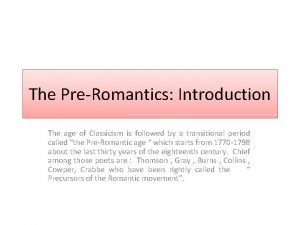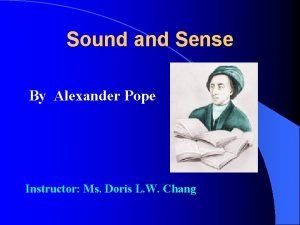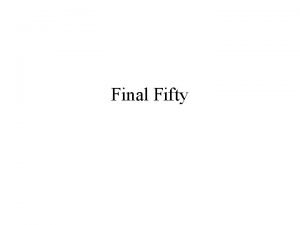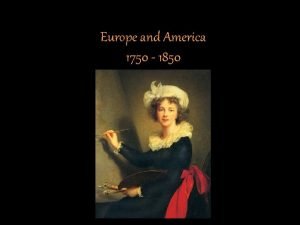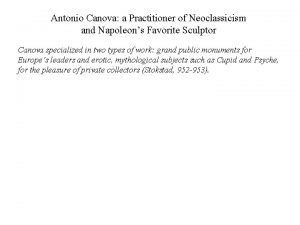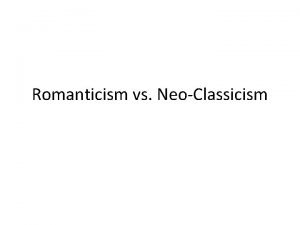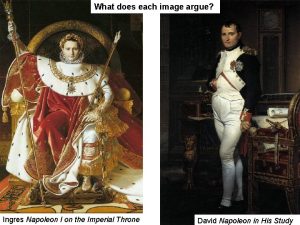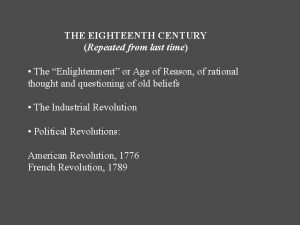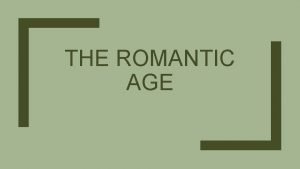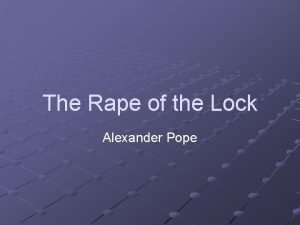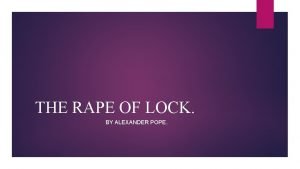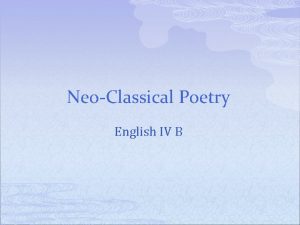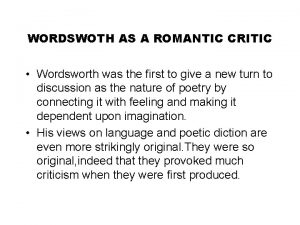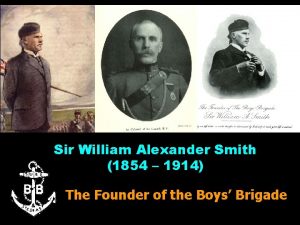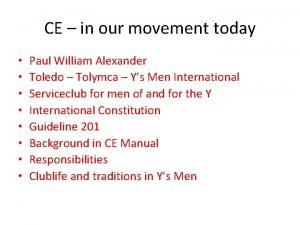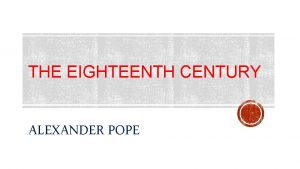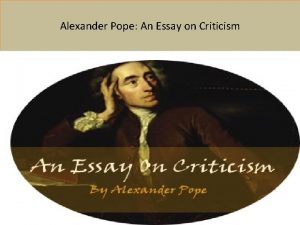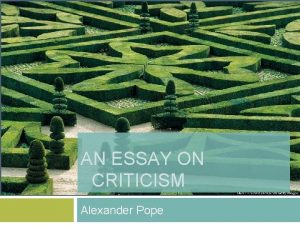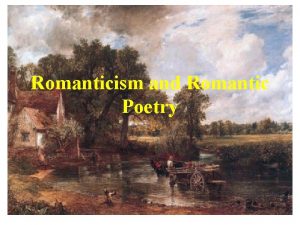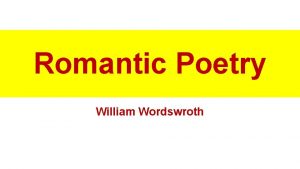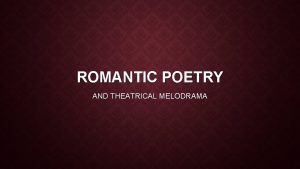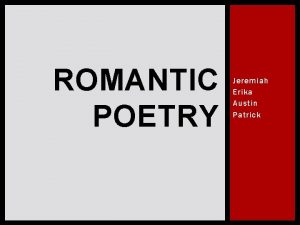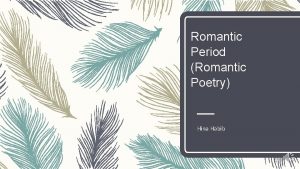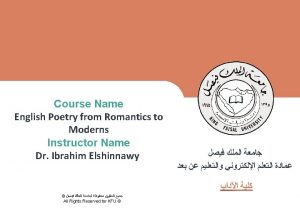Neoclassical and Pre Romantic Poetry Alexander Pope William

















- Slides: 17

Neoclassical and Pre. Romantic Poetry Alexander Pope William Blake

Neoclassicalism 1660 -1798 Neoclassical poetry describes the poetic products of a group of 18 -century poets who revived interest in the Greek and Roman classics for their systematic nature and didactic spirit. ü The hallmarks of this poetry are: heroic couplet, sophisticated diction, and rational language ü The Neoclassical Period is also called the "Enlightenment" due to the increased reverence for logic and disdain for superstition. ü The neoclassical period is divided into three distinct, yet intertwined periods, which are The Age of Restoration The Augustan Age 1700 The Age of Johnson 1660 -1700 1750 1740 -1790 This period marks the British king's restoration of the throne after a long period of Puritan domination in England. Key Figure: John Dryde This period is marked by the imitations of Virgil and Horace's literature in English letters. Key Figure: Alexander Pope This period marks the transition toward the upcoming Romanticism; though, the period is still largely Neoclassical Key Figure: Samuel Johnson

Neoclassical Poetry 1 - Glorification of the classics, Roman and Greek literary product, due to their regularity, didacticism, and restrain of emotion. 2 - Didactic poetry in which the neoclassical poets laid stress on morality and instruction rather than emotion and imagination. 2 - Poetry that communicated the realism of the neoclassicals, especially after the transformation of human nature toward materialism caused by the industrial revolution in Europe which started in 1760. 3 - Intellectual poetry in which reason dominated and eliminated imagination. The idea of having poetry replete with emotions was considered as idiosyncratic and lunatic. 4 - Highly sophisticated language with tight form. Sometime maintaining the form is superior to presenting ideas properly.

Neoclassical Poetry 5 - Society-centered poetry in which the individual was relegated. 6 - The concept of nature in the neoclassical poetry was a group of highly systematic rules rather than a generator of emotions and inspiring imaginations. 7 - The two essential norms a poet should a adopt to be recognized as a poet were - Heroic couplet: pairs of adjacent rhyming lines of iambic pentameter - Sublime poetic diction: highly sophisticated language devoid of emotions and imaginations. Key Figures - Alexander Pope - John Dryden. - Samuel Johnson

Alexander Pope 1688 -1744 • Pope is the acknowledged master of the heroic couplet and one of the primary tastemakers of the Augustan age, Alexander Pope was a central figure in the Neoclassical movement of the early 18 th century. • He was known for having perfected the rhymed couplet form of his idol, John Dryden, and turned it to satiric and philosophical purposes. • An Essay on Criticism (1711) and An Essay on Man (1733 -34) articulate many of the central tenets of 18 th-century aesthetic and moral philosophy. • In his poem An Essay on Criticism Pope says, Let such teach others who themselves excel, And censure freely who have written well. Source: poetryfoundation. com

An Essay on Criticism: Nature and Art First follow NATURE, and your Judgment frame By her just Standard, which is still the same: Unerring Nature, still divinely bright, One clear, unchang'd and Universal Light, Life, Force, and Beauty, must to all impart, At once the Source, and End, and Test of Art from that Fund each just Supply provides, Works without Show, and without Pomp presides: In some fair Body thus th' informing Soul With Spirits feeds, with Vigour fills the whole, Each Motion guides, and ev'ry Nerve sustains; It self unseen, but in th' Effects, remains. Some, to whom Heav'n in Wit has been profuse. Want as much more, to turn it to its use, For Wit and Judgment often are at strife, Tho' meant each other's Aid, like Man and Wife. 'Tis more to guide than spur the Muse's Steed; Restrain his Fury, than provoke his Speed; The winged Courser, like a gen'rous Horse, Shows most true Mettle when you check his Course. Those RULES of old discover'd, not devis'd, Are Nature still, but Nature Methodiz'd; Nature, like Liberty, is but restrain'd By the same Laws which first herself ordain'd.

William Blake 1757 -1827 ü William Blake is a pre-romantic English poet and artist, who used to practice engraving as a craft. ü Blake was a nonconformist and was associated with some of the leading radical thinkers of his day. ü His poetry was not published during his lifetime because it was rebellious and revolutionary, against the norms and expectations of his society. ü In defiance of 18 th-century neoclassical conventions, he privileged imagination over reason in the creation of both his poetry and images, asserting that ideal forms should be constructed not from observations of nature but from inner visions.

William Blake: 1757 -1827 ü In highly symbolic and metaphoric verses, he sharply criticized the established church, not doctrine itself. Clergymen during the 18 th century were not virtuous, but exploited the mysterious aspect of religion hypocritically for their self-interests. They, also, stigmatized any rival as being devilish. ü He also expressed his opposition to the English monarchy, and to 18 th-century political and social tyranny in general. ü Blake believed that his poetry could be read and understood by common people, but he was determined not to sacrifice his vision in order to become popular. ü He constantly criticized the industrial revolution as being immoral and devastative to nature, which is the source of purity, innocence, and inspiration for romantics.

William Blake ü Songs of Innocence and Experience are a collection of lyrical poems that depict two contradictory, yet complementary states of a human soul. ü The first part sets out an imaginative vision of the state of innocence while the second shows how experience challenges, corrupts, and destroys. ü Songs of innocence were dedicated to celebrate the state of innocence and the values of childhood, including human values, simplicity, and fraternity. ü On the other hand, experience was shown in Blake’s poetry as oppressive to the world of innocence. It suppresses man’s goodness and provokes evilness within. ü Nevertheless, he thought that innocence and experience are harmonic. Because experience suppresses the eruption of innocence, they maintain a sort of balance in between.

Sick Rose O Rose thou art sick. The invisible worm, That flies in the night In the howling storm: Has found out thy bed Of crimson joy: And his dark secret love Does thy life destroy.

Sick Rose Brief Summary and Paraphrasing The Sick Rose epitomizes a very scathing image of a rose about to die after being abused by a fly. With hidden intent to destroy the rose, the fly comes close to the rose and shows, hypnotically, a friendly feelings before the rose. Their relation ends with the death of the rose which has been deceived by the hypocrisy of the worm. Form: two quatrains Meter: anapestic meter with many substitutions (irregular meter) Themes The confrontation between innocence and experience Devastation of Industrial Revolution

Sick Rose : Language and Style O Rose, thou art sick. Apostrophe O Rose thou art sick. The invisible worm, Personification invisible worm personification In the howling storm crimson joy dark secret love Metonymy Auditory imagery /onomatopoeia Oxymoron Paradox

Sick Rose: Questions 1. The poetry of William Blake is highly symbolic, and sometimes the meaning is not communicated straightforwardly. Based on this, how can you draw different interpretations for the sick rose that William Blake may have desired to express? (innocence and experience) (nature and industrial revolution) 2. The paradox “crimson joy” may be applied on several relations in the real life. Comment. 3. The poetry of William Blake is characterized of being revolutionary. What are the aspects, themes, and features that make this poem completely against the predominant norms of composing poetry? 4. To what extent do you think that the Sick Rose is laconic, but iconic? 5. What does the word “found out” indicate?

Tyger, burning bright, In the forests of the night; What immortal hand or eye, Could frame thy fearful symmetry? What the hammer? what the chain, In what furnace was thy brain? What the anvil? what dread grasp, Dare its deadly terrors clasp! In what distant deeps or skies. Burnt the fire of thine eyes? On what wings dare he aspire? What the hand, dare seize the fire? When the stars threw down their spears And water'd heaven with their tears: Did he smile his work to see? Did he who made the Lamb make thee? And what shoulder, & what art, Could twist the sinews of thy heart? And when thy heart began to beat, What dread hand? & what dread feet? Tyger burning bright, In the forests of the night: What immortal hand or eye, Dare frame thy fearful symmetry?

Tyger Brief Summary and Paraphrasing In owe and wonder, the speaker contemplates a tiger and perceives it as a harsh element of nature. He thoroughly examines the symmetry, the dreadful appearance, and the creation process of the tiger. After being profoundly confused, the speaker juxtaposes this harsh element with the lamb, which is a soft natural element, and questions whether they are both products of the same creator or not. Form: fix quatrains with rhyme similar to heroic couplet Meter: trochaic tetrameter (with many substitutions) Themes Pure nature and industrial revolution Innocence and experience

Tyger : Language and Style Apostrophe & Tyger, anaphora Oxymoron burning bright fearful symmetry Alliteration distant deeps burning bright Metonymy immortal hand = (metonymy of the absolute ability to create) Shoulder (metonymy of physical ability) what art (metonymy of artistic skill) Refrain The repetition of the last stanza Rhetorical question Could frame thy fearful symmetry? Burnt the fire of thine eyes? On what wings dare he aspire? What the hand, dare seize the fire?

Tyger: Questions ü Under which collection of songs do you think that Tyger is categorized? Why? ü The poetry of William Blake is characterized by combining contraries. How can you argue for or against this claim with reference to Tyger? ü What are the revolutionary aspects in William Blake’s Tyger? ü Being highly symbolic validates many interpretations for Blake’s poetry. How can you draw different, yet valid, interpretations for Tyger? ü Define presupposition and rhetorical question, and then indicate how Bake uses the two techniques to render his argument. ü How can you interpret the substitution of the word “could” in the first stanza with the word “dare” in the last stanza. ü Write an academic paragraph in which you analyze Tyger with reference to Blake-peculiar philosophy of innocence and experience. ü “And what shoulder, & what art”, what are the two things needed for creation according to this rhetorical question?
 Poem about romantic period
Poem about romantic period Neoclassicism vs romanticism
Neoclassicism vs romanticism Pre romanticism and romanticism
Pre romanticism and romanticism Sound and sense by alexander pope
Sound and sense by alexander pope The apotheosis of homer
The apotheosis of homer Y no hai remedio khan academy
Y no hai remedio khan academy Neoclassicism napoleon
Neoclassicism napoleon Romanticism vs neoclassicism art
Romanticism vs neoclassicism art Napoleon crossing the alps neoclassical or romantic
Napoleon crossing the alps neoclassical or romantic Oath of the horatii neoclassical or romantic
Oath of the horatii neoclassical or romantic Augustan poetry aim
Augustan poetry aim Who is chrispissa
Who is chrispissa The rape of the lock by alexander pope
The rape of the lock by alexander pope Neoclassical poetry
Neoclassical poetry William wordsworth as a romantic critic
William wordsworth as a romantic critic Sir william alexander smith
Sir william alexander smith Paul william alexander
Paul william alexander Osnowa dokumentu
Osnowa dokumentu


